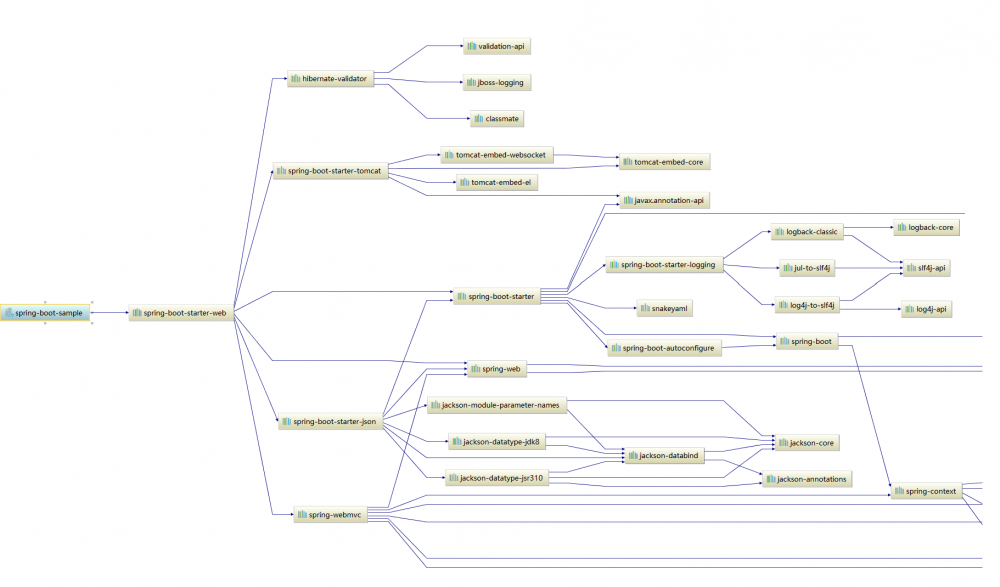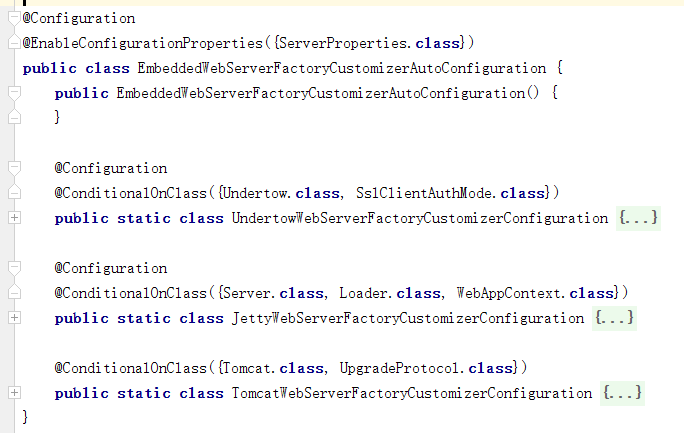最简单的一个 Spring Boot 项目
最近在项目中使用 Spring Boot,对它的简单易用印象很深刻。Spring Boot 最大的特点是它大大简化了传统 Spring 项目的配置,使用 Spring Boot 开发 Web 项目,几乎没有任何的 xml 配置。而且它最方便的地方在于它内嵌了 Servlet 容器(可以自己选择 Tomcat、Jetty 或者 Undertow),这样我们就不需要以 war 包来部署项目,直接使用 java -jar hello.jar 就可以运行一个 Web 项目。
我们以 Maven 项目为例,Spring Boot 除了支持 Maven,还支持 Gradle 项目。一个最简单的 Spring Boot Web 项目只有 3 个文件(其实如果想要更简单一点,入口和控制器类甚至可以写在同一个文件中)。首先是一个入口文件:
@SpringBootApplication
public class Application {
public static void main(String[] args) {
SpringApplication.run(Application.class, args);
}
}
然后再写一个控制器类:
@RestController
public class HelloController {
@RequestMapping("/")
public String index() {
return "Hello World!";
}
}
最后是这个项目的 POM(Project Object Model,项目对象模型) 文件:
<?xml version="1.0" encoding="UTF-8"?>
<project xmlns="http://maven.apache.org/POM/4.0.0"
xmlns:xsi="http://www.w3.org/2001/XMLSchema-instance"
xsi:schemaLocation="http://maven.apache.org/POM/4.0.0 http://maven.apache.org/xsd/maven-4.0.0.xsd">
<modelVersion>4.0.0</modelVersion>
<groupId>com.stonie</groupId>
<artifactId>spring-boot-sample</artifactId>
<version>1.0-SNAPSHOT</version>
<parent>
<groupId>org.springframework.boot</groupId>
<artifactId>spring-boot-starter-parent</artifactId>
<version>2.0.2.RELEASE</version>
</parent>
<dependencies>
<dependency>
<groupId>org.springframework.boot</groupId>
<artifactId>spring-boot-starter-web</artifactId>
</dependency>
</dependencies>
<properties>
<java.version>1.8</java.version>
</properties>
<build>
<plugins>
<plugin>
<groupId>org.springframework.boot</groupId>
<artifactId>spring-boot-maven-plugin</artifactId>
</plugin>
</plugins>
</build>
</project>
在新建 Spring Boot 项目的时候要注意一点,入口类必须放在某个包下面,而不能放在默认包(也就是说不能直接放在 src/main/java 目录下),否则会导致项目启动失败(其实原因很简单,因为 Spring Boot 通过 @ComponentScan 来扫描 Bean,如果入口类放在默认包下,也就意味着 Spring Boot 要扫描所有 jar 包中的所有的类):
** WARNING ** : Your ApplicationContext is unlikely to start due to a @ComponentScan of the default package.
至此,我们就写好了一个 Spring Boot 项目,完整的源码可以参考 这里 。从代码上看项目非常简单,但是这里有很多值得我们学习的地方。
一、从 SpringBootApplication 注解看 Spring Boot 自动配置原理
Spring Boot 项目通常都有一个入口类,入口类中的 main 方法和标准的 Java 应用入口方法是一样的,在上面的例子中,这个 main 方法中只有一行代码: SpringApplication.run() ,这是一个静态方法,用于启动整个 Spring Boot 项目。和其他 Java 程序不一样的是,入口类上多了一个 @SpringBootApplication 注解,这是非常重要的一个注解,它由多个注解组合而成,包括了: @SpringBootConfiguration 、 @EnableAutoConfiguration 、 @ComponentScan 和其他一些注解。Spring Boot 是如何做到不需要任何配置文件的,看名字也可以猜出来,其秘密就在于 @EnableAutoConfiguration 这个注解实现了自动配置。这个注解的实现如下:
@Target({ElementType.TYPE})
@Retention(RetentionPolicy.RUNTIME)
@Documented
@Inherited
@AutoConfigurationPackage
@Import({AutoConfigurationImportSelector.class})
public @interface EnableAutoConfiguration {
String ENABLED_OVERRIDE_PROPERTY = "spring.boot.enableautoconfiguration";
Class<?>[] exclude() default {};
String[] excludeName() default {};
}
其中最为重要的一行代码为: @Import({AutoConfigurationImportSelector.class}) ,其中 @Import 是 Spring 提供的一个注解,可以导入配置类或者 Bean 到当前类中。 AutoConfigurationImportSelector 类的实现比较复杂,简单来说就是扫描所有 jar 包中的 META-INF/spring-factories 文件,这个文件中声明了有哪些自动配置。我们可以打开 spring-boot-autoconfigure.jar 文件,这里就有这个文件,其中定义了一个属性 org.springframework.boot.autoconfigure.EnableAutoConfiguration 如下所示(有删减):
# Auto Configure org.springframework.boot.autoconfigure.EnableAutoConfiguration=/ org.springframework.boot.autoconfigure.admin.SpringApplicationAdminJmxAutoConfiguration,/ org.springframework.boot.autoconfigure.aop.AopAutoConfiguration,/ org.springframework.boot.autoconfigure.amqp.RabbitAutoConfiguration,/ ... org.springframework.boot.autoconfigure.data.ldap.LdapRepositoriesAutoConfiguration,/ org.springframework.boot.autoconfigure.data.mongo.MongoDataAutoConfiguration,/ org.springframework.boot.autoconfigure.data.mongo.MongoReactiveDataAutoConfiguration,/ org.springframework.boot.autoconfigure.data.mongo.MongoReactiveRepositoriesAutoConfiguration,/ org.springframework.boot.autoconfigure.data.mongo.MongoRepositoriesAutoConfiguration,/ org.springframework.boot.autoconfigure.data.neo4j.Neo4jDataAutoConfiguration,/ org.springframework.boot.autoconfigure.data.neo4j.Neo4jRepositoriesAutoConfiguration,/ org.springframework.boot.autoconfigure.data.solr.SolrRepositoriesAutoConfiguration,/ org.springframework.boot.autoconfigure.data.redis.RedisAutoConfiguration,/ org.springframework.boot.autoconfigure.data.redis.RedisReactiveAutoConfiguration,/ org.springframework.boot.autoconfigure.data.redis.RedisRepositoriesAutoConfiguration,/ org.springframework.boot.autoconfigure.data.rest.RepositoryRestMvcAutoConfiguration,/ org.springframework.boot.autoconfigure.data.web.SpringDataWebAutoConfiguration,/ ... org.springframework.boot.autoconfigure.ldap.embedded.EmbeddedLdapAutoConfiguration,/ org.springframework.boot.autoconfigure.ldap.LdapAutoConfiguration,/ org.springframework.boot.autoconfigure.liquibase.LiquibaseAutoConfiguration,/ org.springframework.boot.autoconfigure.mail.MailSenderAutoConfiguration,/ org.springframework.boot.autoconfigure.mail.MailSenderValidatorAutoConfiguration,/ org.springframework.boot.autoconfigure.mongo.embedded.EmbeddedMongoAutoConfiguration,/ org.springframework.boot.autoconfigure.mongo.MongoAutoConfiguration,/ org.springframework.boot.autoconfigure.mongo.MongoReactiveAutoConfiguration,/ org.springframework.boot.autoconfigure.mustache.MustacheAutoConfiguration,/ org.springframework.boot.autoconfigure.orm.jpa.HibernateJpaAutoConfiguration,/ org.springframework.boot.autoconfigure.quartz.QuartzAutoConfiguration,/ ... org.springframework.boot.autoconfigure.web.client.RestTemplateAutoConfiguration,/ org.springframework.boot.autoconfigure.web.embedded.EmbeddedWebServerFactoryCustomizerAutoConfiguration,/ org.springframework.boot.autoconfigure.web.reactive.HttpHandlerAutoConfiguration,/ org.springframework.boot.autoconfigure.web.reactive.ReactiveWebServerFactoryAutoConfiguration,/ org.springframework.boot.autoconfigure.web.reactive.WebFluxAutoConfiguration,/ org.springframework.boot.autoconfigure.web.reactive.error.ErrorWebFluxAutoConfiguration,/ org.springframework.boot.autoconfigure.web.reactive.function.client.WebClientAutoConfiguration,/ org.springframework.boot.autoconfigure.web.servlet.DispatcherServletAutoConfiguration,/ org.springframework.boot.autoconfigure.web.servlet.ServletWebServerFactoryAutoConfiguration,/ org.springframework.boot.autoconfigure.web.servlet.error.ErrorMvcAutoConfiguration,/ org.springframework.boot.autoconfigure.web.servlet.HttpEncodingAutoConfiguration,/ org.springframework.boot.autoconfigure.web.servlet.MultipartAutoConfiguration,/ org.springframework.boot.autoconfigure.web.servlet.WebMvcAutoConfiguration,/ org.springframework.boot.autoconfigure.websocket.reactive.WebSocketReactiveAutoConfiguration,/ org.springframework.boot.autoconfigure.websocket.servlet.WebSocketServletAutoConfiguration,/ org.springframework.boot.autoconfigure.websocket.servlet.WebSocketMessagingAutoConfiguration,/ org.springframework.boot.autoconfigure.webservices.WebServicesAutoConfiguration
可以看到 Spring Boot 已经内置了大量的自动配置,我们查看我们这个项目的依赖关系,如下图:

我们这个项目中使用了 spring-boot-starter-web ,可以看出它依赖于 spring-boot-starter-tomcat 和 spring-webmvc,所以这里会自动对 Tomcat 和 Spring MVC 进行配置。但是这里有一个问题,这里列出来的自动配置有那么多,难道 Spring Boot 都要一个个的去加载配置吗?当然不是,Spring Boot 也没那么傻,所以这里就要重点介绍一下从 Spring 4.x 开始引入的一个新特性: @Conditional (也叫 条件注解 )。
@Conditional 可以根据条件来创建 Bean,譬如随便拿上面一个自动配置类 RedisAutoConfiguration 来看,其中用到的条件注解为 @ConditionalOnClass({RedisOperations.class}) 说明只有在 RedisOperations 类存在时才会自动配置,而我们这个项目并没有引入 redis,所以并不会加载 redis 的配置。
@Configuration
@ConditionalOnClass({RedisOperations.class})
@EnableConfigurationProperties({RedisProperties.class})
@Import({LettuceConnectionConfiguration.class, JedisConnectionConfiguration.class})
public class RedisAutoConfiguration {
}
那么我们的程序在启动的时候都自动加载了哪些配置呢?我们可以通过命令行参数 --debug 来启动 Spring Boot 应用:
$ java -jar hello.jar --debug
启动时控制台会打印出详情的信息,类似于下面这样(实际打印的日志会非常多,有兴趣的同学可以自行挖掘):
============================
CONDITIONS EVALUATION REPORT
============================
Positive matches:
-----------------
EmbeddedWebServerFactoryCustomizerAutoConfiguration.TomcatWebServerFactoryCustomizerConfiguration matched:
- @ConditionalOnClass found required classes 'org.apache.catalina.startup.Tomcat', 'org.apache.coyote.UpgradeProtocol'; @ConditionalOnMissingClass did not find unwanted class (OnClassCondition)
ServletWebServerFactoryAutoConfiguration matched:
- @ConditionalOnClass found required class 'javax.servlet.ServletRequest'; @ConditionalOnMissingClass did not find unwanted class (OnClassCondition)
- found ConfigurableWebEnvironment (OnWebApplicationCondition)
ServletWebServerFactoryAutoConfiguration#tomcatServletWebServerFactoryCustomizer matched:
- @ConditionalOnClass found required class 'org.apache.catalina.startup.Tomcat'; @ConditionalOnMissingClass did not find unwanted class (OnClassCondition)
ServletWebServerFactoryConfiguration.EmbeddedTomcat matched:
- @ConditionalOnClass found required classes 'javax.servlet.Servlet', 'org.apache.catalina.startup.Tomcat', 'org.apache.coyote.UpgradeProtocol'; @ConditionalOnMissingClass did not find unwanted class (OnClassCondition)
- @ConditionalOnMissingBean (types: org.springframework.boot.web.servlet.server.ServletWebServerFactory; SearchStrategy: current) did not find any beans (OnBeanCondition)
WebMvcAutoConfiguration matched:
- @ConditionalOnClass found required classes 'javax.servlet.Servlet', 'org.springframework.web.servlet.DispatcherServlet', 'org.springframework.web.servlet.config.annotation.WebMvcConfigurer'; @ConditionalOnMissingClass did not find unwanted class (OnClassCondition)
- found ConfigurableWebEnvironment (OnWebApplicationCondition)
- @ConditionalOnMissingBean (types: org.springframework.web.servlet.config.annotation.WebMvcConfigurationSupport; SearchStrategy: all) did not find any beans (OnBeanCondition)
Negative matches:
-----------------
ActiveMQAutoConfiguration:
Did not match:
- @ConditionalOnClass did not find required classes 'javax.jms.ConnectionFactory', 'org.apache.activemq.ActiveMQConnectionFactory' (OnClassCondition)
我从日志中挑选中我们这里比较感兴趣的 EmbeddedWebServerFactoryCustomizerAutoConfiguration ,我们看看它的实现:

从这里就可以看出 Spring Boot 支持三种嵌入的 Web Server:Undertow、Jetty 和 Tomcat。根据上面的依赖关系 spring-boot-starter-web 默认是加载 spring-boot-starter-tomcat 的,所以这里会自动加载 Tomcat 的配置。
如果我们想改变默认的 Web Server,譬如改成轻量级的 Undertow,可以在 POM 文件中使用 exclusion 移除对 spring-boot-starter-tomcat 的引用,并加上对 spring-boot-starter-undertow 的引用,如下:
<dependencies>
<dependency>
<groupId>org.springframework.boot</groupId>
<artifactId>spring-boot-starter-web</artifactId>
<exclusions>
<exclusion>
<groupId>org.springframework.boot</groupId>
<artifactId>spring-boot-starter-tomcat</artifactId>
</exclusion>
</exclusions>
</dependency>
<dependency>
<groupId>org.springframework.boot</groupId>
<artifactId>spring-boot-starter-undertow</artifactId>
</dependency>
</dependencies>
二、探究 Spring MVC 如何映射请求?
第二个文件是控制器类,粗看上去就是一个普通的类,外加上一个方法,只不过加上了两个注解 @RestController 和 @RequestMapping("/") 这个方法竟然就可以处理 Web 请求了。是不是觉得这有点神奇?为什么在浏览器里访问 http://localhost:8080 时页面会显示出这里返回的 Hello World! ?
其实,这一切都是 Spring MVC 的功劳。只不过在 Spring Boot 项目里,Spring MVC 的配置被简化了。我们先回忆一下在传统的 Spring MVC 里如何实现一个控制器类,首先,我们要先在 web.xml 里定义 DispatcherServlet ,并为这个 Servlet 配置相应的 servlet-mapping ,类似于下面这样:
<web-app>
<display-name>appName</display-name>
<context-param>
<param-name>contextConfigLocation</param-name>
<param-value>
classpath:/applicationContext.xml
</param-value>
</context-param>
<listener>
<listener-class>
org.springframework.web.context.ContextLoaderListener
</listener-class>
</listener>
<servlet>
<servlet-name>dispatcher</servlet-name>
<servlet-class>
org.springframework.web.servlet.DispatcherServlet
</servlet-class>
<load-on-startup>1</load-on-startup>
</servlet>
<servlet-mapping>
<servlet-name>dispatcher</servlet-name>
<url-pattern>/*</url-pattern>
</servlet-mapping>
</web-app>
可以说 DispatcherServlet 是 Spring MVC 的核心,通过上面这个配置,它就可以截获 Web 应用的所有请求并将其分派给相应的处理器进行处理。在 Servlet 3.0 之后,还可以通过编程的方式来配置 Servlet 容器,Spring MVC 提供了一个接口 WebApplicationInitializer ,通过实现这个接口也可以达到 web.xml 配置文件的目的,如下所示:
public class AppInitializer implements WebApplicationInitializer {
@Override
public void onStartup(ServletContext container) {
XmlWebApplicationContext appContext = new XmlWebApplicationContext();
appContext.setConfigLocation("/WEB-INF/spring/dispatcher-config.xml");
ServletRegistration.Dynamic dispatcher =
container.addServlet("dispatcher", new DispatcherServlet(appContext));
dispatcher.setLoadOnStartup(1);
dispatcher.addMapping("/");
}
}
那么 DispatcherServlet 是如何把 HTTP 请求映射到控制器的某个方法的呢?感兴趣的可以看看 DispatcherServlet 的源码,其实在 DispatcherServlet 初始化的时候,会扫描当前容器所有的 Bean,将包含 @Controller 和 @RequestMapping 注解的类和方法,映射到 HandleMappering ,为了实现这一点,Spring MVC 一般都有一个 dispatch-servlet.xml 配置文件:
<beans>
<context:component-scan base-package="com.stonie.hello" />
<bean class="org.springframework.web.servlet.mvc.method.annotation.RequestMappingHandlerMapping" />
<bean class="org.springframework.web.servlet.mvc.method.annotation.RequestMappingHandlerAdapter" />
</beans>
其中, component-scan 用于开启注解扫描, RequestMappingHandlerMapping 叫做 处理器映射 , RequestMappingHandlerAdapter 叫做 处理器适配器 (在老版本的 Spring MVC 中你可能看到的是 DefaultAnnotationHandlerMapping 和 AnnotationMethodHandlerAdapter )。这两个类负责将 HTTP 方法,HTTP 路径,HTTP 参数匹配到具体的 @RequestMapping 注解的类和方法上。
@RequestMapping 注解的方法所支持的参数类型和返回类型非常丰富和灵活,从这里也可以看出 Spring MVC 的强大之处。这样虽然让开发人员可以根据需要任意选择,但是也会给开发人员带来困惑,可以参考这篇博客的总结: Spring MVC @RequestMapping 方法所支持的参数类型和返回类型详解 。
上面就是 Spring MVC 实现请求映射的原理,在传统的 Spring MVC 项目中,这样的配置文件是很常见的,但是在 Spring Boot 项目中,这些配置都自动实现了,可以再深入研究下 DispatcherServletAutoConfiguration 和 WebMvcAutoConfiguration 这两个类。
三、解读 POM 文件
POM 的 全称叫做 Project Object Model,翻译过来就是项目对象模型,它用来定义项目的基本信息,构建步骤,依赖信息等等。pom.xml 文件作为 Maven 项目的核心,和 Make 的 Makefile、Ant 的 build.xml 文件一样。
在这篇博客的最后,让我们来看看这个项目的 pom.xml 文件。首先我们定义了三个元素: groupId 、 artifactId 和 version ,这被称为 Maven 坐标 ,Maven 坐标保证了每个项目都有一个唯一的坐标值,当我们需要在其他项目中引用这个项目时,通过坐标就可以很方便的定位到该项目。
然后下面定义了一个依赖 spring-boot-starter-web ,并声明这个 POM 继承自 spring-boot-starter-parent ,别小看这一句继承,里面可是另有乾坤。你可以打开 spring-boot-starter-parent 的 POM 文件,可以发现它又继承自 spring-boot-dependencies 。在 spring-boot-starter-parent 中定义了一堆的插件,这些插件让 Maven 也能构建 Spring Boot 项目,其中最重要的一个插件是 spring-boot-maven-plugin ,这就是我们项目后面要用到的插件。另外,在 spring-boot-dependencies 中定义了一堆的依赖,足足有 3000+ 行,我们前面介绍 Spring Boot 的自动配置原理时就说过,它定义了很多自动配置类,几乎能用到的依赖它都依赖了。
在 pom.xml 文件的 <build> 元素中定义了 spring-boot-maven-plugin 插件之后,就可以运行下面的命令和平常的 jar 包一样进行打包了:
$ mvn clean package
而如果在这里没有定义 <build> 元素,也可以通过下面的命令来打包:
$ mvn clean package spring-boot:repackage
如果不用这个命令,打出来的包里只有我们写的两个类文件,所有依赖的 jar 包都没有包含进去,这样的 jar 包是无法运行的。而 spring-boot:repackage 插件会在执行完 mvn package 之后再次进行打包为可执行的软件包,并且将 mvn package 打的原始的包命名为 *.jar.original。
我们可以打开 *.jar.original 里的 META-INF/MANIFEST.MF 文件:
Manifest-Version: 1.0 Implementation-Title: spring-boot-sample Implementation-Version: 1.0-SNAPSHOT Built-By: aneasystone Implementation-Vendor-Id: com.stonie Created-By: Apache Maven 3.3.9 Build-Jdk: 1.8.0_111 Implementation-URL: https://projects.spring.io/spring-boot/#/spring-bo ot-starter-parent/spring-boot-sample
然后再打开 *.jar 里的 META-INF/MANIFEST.MF 文件:
Manifest-Version: 1.0 Implementation-Title: spring-boot-sample Implementation-Version: 1.0-SNAPSHOT Built-By: aneasystone Implementation-Vendor-Id: com.stonie Spring-Boot-Version: 2.0.2.RELEASE Main-Class: org.springframework.boot.loader.JarLauncher Start-Class: com.stonie.Application Spring-Boot-Classes: BOOT-INF/classes/ Spring-Boot-Lib: BOOT-INF/lib/ Created-By: Apache Maven 3.3.9 Build-Jdk: 1.8.0_111 Implementation-URL: https://projects.spring.io/spring-boot/#/spring-bo ot-starter-parent/spring-boot-sample
可以发现新打的包里多了五行代码:
Spring-Boot-Version: 2.0.2.RELEASE Main-Class: org.springframework.boot.loader.JarLauncher Start-Class: com.stonie.Application Spring-Boot-Classes: BOOT-INF/classes/ Spring-Boot-Lib: BOOT-INF/lib/
并且我们可以在 BOOT-INF/lib/ 目录下找到项目依赖的所有 jar 包,说明 spring-boot-maven-plugin 插件已经自动帮我们把 jar 包转换成了一个可运行的 Spring Boot 应用。
要理解 Spring Boot 是如何通过 Maven 打包的,这里有两个非常重要的概念: 生命周期 和 插件目标 。Maven 定义了三套生命周期:clean、default 和 site,其中 clean 用于清理项目,default 用于执行构建项目需要的具体步骤,site 用于发布项目站点。其中 clean 和 default 是最常使用的。譬如我们平常执行 mvn clean compile 来清理并编译项目时就用到了 clean 和 default 生命周期,其中, mvn clean 调用的是 clean 生命周期的 clean 阶段, mvn compile 调用的是 default 生命周期的 compile 阶段。
通过 mvn 命令不仅可以直接调用生命周期的某个阶段,还可以调用某个插件目标,譬如上面的 mvn spring-boot:repackage 就是调用 spring-boot 插件的 repackage 目标。实际上, Maven 的核心就是插件,它是一款基于插件的框架,所有的工作其实都是交给插件完成的 ,包括上面说的 clean 和 compile 实际上就是通过 clean:clean 和 compiler:compile 这两个插件完成的。
不过上面的命令中还有一个问题,执行 mvn spring-boot:repackage 时,Maven 为什么可以根据 spring-boot 这个名字定位到 spring-boot-maven-plugin 这个插件的?这是因为 spring-boot 就是 spring-boot-maven-plugin 插件,这被称为 插件前缀 ,为了方便书写 mvn 命令,可以给每个插件都定义一个插件前缀,这样就不用在命令行中写那么长的插件名称了。
总结
越是看似简单的东西,背后越是蕴含着无限玄机,从平时的开发工作中,要善于从细节中发现问题。虽然这个 Spring Boot 项目只有三个非常简单的文件,但是想彻底弄懂每个文件,绝对不是那么容易。
参考
- Building an Application with Spring Boot
- Spring application does not start outside of a package
- Spring Boot 的自动配置
- Spring Boot 学习笔记 02 -- 深入了解自动配置
- Difference between spring @Controller and @RestController annotation
- Spring6:基于注解的 Spring MVC(上篇)
- Spring MVC @RequestMapping 方法所支持的参数类型和返回类型详解
- Spring Boot 的 Maven 插件 Spring Boot Maven plugin 详解
- Spring Boot Maven Plugin
- 本文标签: 生命 cat Service App id 翻译 REST client EnableAutoConfiguration tomcat JMS UI plugin apache XML 模型 pom 总结 博客 find Property CTO MQ 编译 软件 build amqp servlet Quartz 配置 mapper java Select springboot maven 开发 http tar 处理器 代码 WebService ldap 插件 schema Lua JPA map ORM spring Document validator 源码 dependencies src 适配器 https connectionFactory IDE AOP 站点 list mongo mail solr ACE apr bean 目录 HTML Spring Boot classpath 参数 lib 静态方法 ip ActiveMQ redis IO web value bug jetty Connection
- 版权声明: 本文为互联网转载文章,出处已在文章中说明(部分除外)。如果侵权,请联系本站长删除,谢谢。
- 本文海报: 生成海报一 生成海报二










![[HBLOG]公众号](https://www.liuhaihua.cn/img/qrcode_gzh.jpg)

